Whenever I think about surfing, Hawaii always comes to mind. There’s a special energy in the islands, where top surfers gather every year to test their skills on some of the world’s most famous waves.
The best surfing competitions in Hawaii bring together world-class athletes, big ocean swells, and a vibrant surf culture unlike anywhere else on earth.
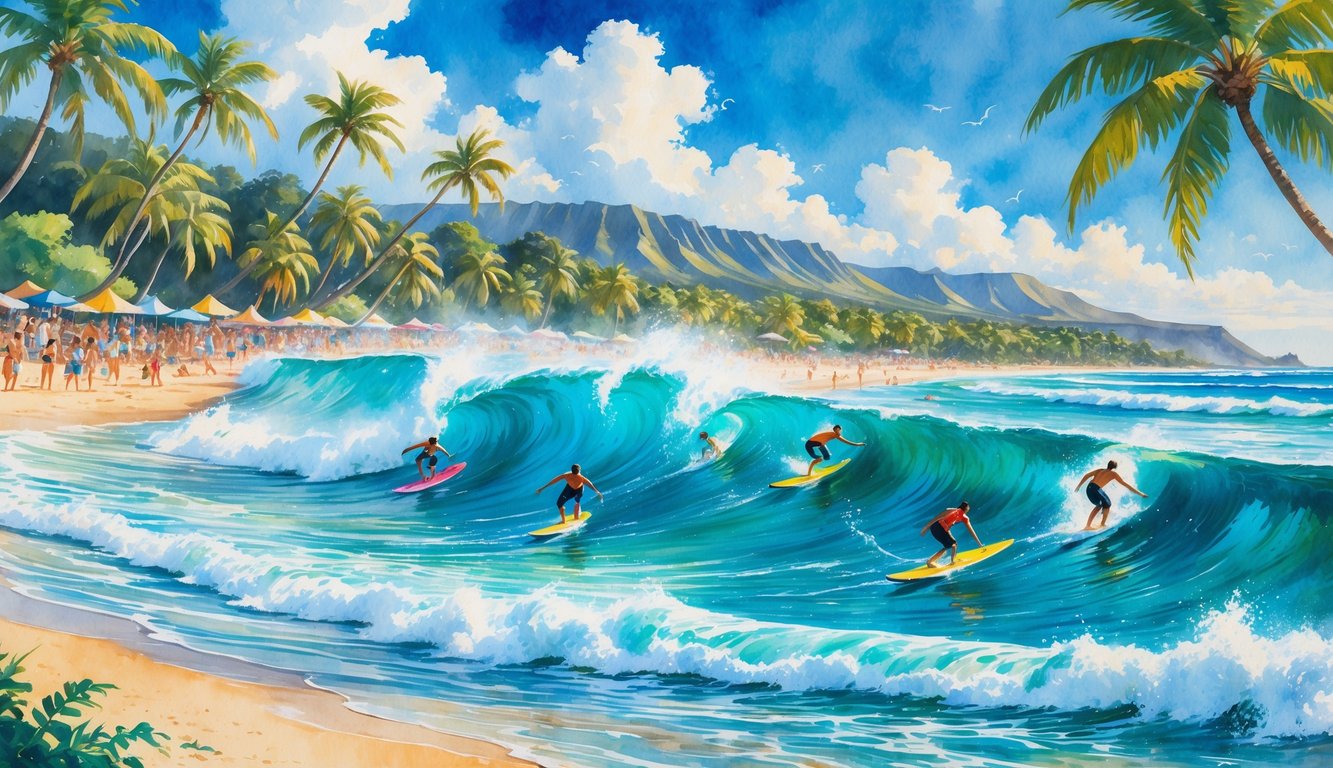
Events like the Billabong Pipe Masters and the Vans World Cup of Surfing at Sunset Beach attract the biggest names in the sport. Fans from around the world come to watch these major contests.
If you want to see the surf scene at its peak, these competitions are a must. Hawaii is where the action happens, whether you cheer from shore or follow the latest updates online.
If you’re curious about the most important surfing competitions on the islands, or want tips on catching the excitement in person, you’re in the right place.
Surfing Culture and History in Hawaii
Surfing has a long tradition in Hawaii. The sport blends ancient customs with the excitement of modern surf competitions.
The sport’s deep roots, famous spots, and unique contests make Hawaii a world leader in surfing.
The Origins of Surf Contests in Hawaii
Surfing began in Hawaii, where early Hawaiians rode wooden boards on ocean waves hundreds of years ago. Surfing was part of daily life and spiritual tradition, often practiced by ali‘i, or Hawaiian royalty.
Long ago, people held friendly yet important surf contests to show their skills and challenge each other. Chiefs and commoners both competed, and these contests could decide status and respect in the community.
In the 20th century, modern surf competitions became popular. Duke Kahanamoku, known as the “Father of Modern Surfing,” helped make the sport famous worldwide.
His influence shaped Hawaii’s surf contests into major events that drew big crowds and talented surfers from around the globe, as World Surfers describes.
Why Hawaii Is the Heart of Competitive Surfing
The North Shore of Oahu is home to some of the best waves and most exciting contests anywhere. Massive winter swells draw top surfers, sponsors, and photographers every year.
Surfing competitions in Hawaii connect closely to its culture, landscape, and community. The warm water, huge waves, and welcoming locals make these contests unforgettable.
Each winter, contests like the Pipeline Masters, Eddie Aikau Big Wave Invitational, and Triple Crown of Surfing take over the North Shore. These events attract big crowds and international attention.
These contests help keep the sport’s Hawaiian roots alive. Visiting local surf shops and museums is a great way to learn about this deep connection to place and history.
For example, North Shore Surf Shop in Haleiwa displays historic boards, as noted in Royal Caribbean’s guide.
Traditional and Modern Surfing Events
Surfing in Hawaii mixes old and new traditions. Ancient surf contests were simple and judged by skill, bravery, and style.
Today’s competitions are larger and more organized, but still look for those same qualities. Many events honor tradition by starting with Hawaiian chants, ceremonies, and blessings at the beach.
This keeps surfing’s cultural roots strong. Along with professional contests, community events for youth and amateur surfers help pass these traditions to a new generation.
Programs often include lessons about ocean safety, conservation, and respect for the land. Young surfers in Hawaii learn to blend respect for the past with new technology and styles.
This approach helps keep the sport’s unique spirit alive, as highlighted by Waves Cultures.
Iconic Surfing Locations in Hawaii

Hawaii is home to some of the most famous waves in the world. Each spot offers something unique, from powerful surf breaks to legendary competitions and stunning scenery.
North Shore of Oahu
When I think of world-class surfing, the North Shore of Oahu comes to mind first. This stretch of coastline is about 7 miles long and is packed with surf breaks that attract top surfers every year.
The best-known beaches here include Sunset Beach, Banzai Pipeline, and Waimea Bay. Each offers different wave conditions.
During the winter, waves can reach heights of over 30 feet.
Notable features of the North Shore of Oahu:
| Beach | Wave Height | Season |
|---|---|---|
| Sunset Beach | Up to 25 feet | Fall to Spring |
| Turtle Bay | 4-6 feet | Year-round |
| Ehukai (Pipeline) | 15-30+ feet | Winter |
Surfers from around the world travel here for competitions and to challenge themselves. The North Shore also has plenty of places to watch the action, making it a great spot for fans and families.
Banzai Pipeline
The Banzai Pipeline, often called Pipeline, is probably the most famous surf break in Hawaii. You can find it at Ehukai Beach Park on the North Shore.
Pipeline stands out because of its steep, fast, and powerful waves that break right over a shallow reef. The waves here form excellent “tubes” or “barrels,” which are every surfer’s dream.
Only skilled and experienced surfers can ride these waves safely since Pipeline is known for its risks. The spot hosts several major competitions each year, like the Pipe Masters.
For fans, watching at Pipeline is exciting. The view of athletes dropping into huge waves is unforgettable.
You can find more about surf contests at this spot here.
Waimea Bay
Waimea Bay is another iconic surf spot on the North Shore. In winter, the bay hosts some of the largest waves in the world, reaching over 30 feet during big swells.
The surf break here is wide and deep, offering a different challenge compared to Pipeline. Waimea Bay is famous for the Eddie Aikau Big Wave Invitational, an event that only happens when the waves reach at least 20 feet for several hours.
Surfers must paddle into these massive waves, which takes special skill and bravery. Waimea is also a beautiful spot when the surf is calm, and many visit just for the views.
Learn about the Eddie Aikau contest at Waimea Bay.
Major Annual Surfing Competitions
Every year, Hawaii hosts some of the world’s most iconic professional surfing contests. These events attract top athletes and huge crowds, with challenging waves and big prizes on the line.
Vans Triple Crown of Surfing
The Vans Triple Crown of Surfing is a legendary series made up of three challenging contests on Oahu’s North Shore. These are the Hawaiian Pro at Haleiwa, the Vans World Cup of Surfing at Sunset Beach, and the Vans Pipe Masters at Banzai Pipeline.
Each winter, this event crowns the best all-around North Shore surfer. Winning the Triple Crown takes serious skill and local knowledge, since the three waves are so different.
The Triple Crown draws both top professionals and local talent. Each contest offers valuable World Surf League points.
Many surfers see it as the highlight of the winter surf season in Hawaii. You can see current schedules and updates on the Hawaii Surf Contest Schedule page.
Billabong Pipe Masters
The Billabong Pipe Masters is one of the most famous and important contests in the surfing world. It takes place at the Banzai Pipeline on Oahu’s North Shore, usually in December.
The Pipeline is known for its fast, powerful waves that break over a shallow reef. Surf fans love seeing the world’s best take on this challenge.
The Pipe Masters often decides the World Surf League Championship, making every heat extremely exciting. Competing at Pipeline tests barrel riding skills and bravery.
The event is a core part of the Vans Triple Crown and is watched closely by fans, media, and other pro surfers. For more details about North Shore competitions, check out the Haleiwatown guide.
Eddie Aikau Big Wave Invitational
The Eddie Aikau Big Wave Invitational, also called “The Eddie,” honors the life of famous Hawaiian lifeguard and surfer Eddie Aikau. Organizers hold this big wave surf contest at Waimea Bay on Oahu, but only run it when the waves reach a minimum of 20 feet Hawaiian scale (about 40-foot faces).
This event is one of the most thrilling because it’s not held every year—only when the surf is truly giant. The format is unique: it’s invite-only, with some of the best big wave riders from Hawaii and beyond competing for pride rather than a huge prize purse.
Spectators hope for the right conditions because when “The Eddie is On,” the atmosphere at Waimea Bay is electric. The contest tests skill, bravery, and the true spirit of Hawaiian surfing legends.
Sunset Pro
The Sunset Pro is one of the key surf contests at Sunset Beach, a spot known for large, powerful waves and shifting peaks. This competition is usually part of the World Surf League’s Championship Tour or the Qualifying Series.
The Sunset Pro stands out because Sunset’s waves challenge even experienced professionals with their size and raw energy. The event can be make-or-break for surfers hoping to earn points and qualify for the Championship Tour.
Surfers need to handle long paddle-outs and constantly changing conditions. The lineup is stacked with talent and local heroes, making the contest unpredictable and exciting to watch.
You can find event dates and more information on the Aloha Surf Guide events calendar.
Professional Surfers and Their Achievements
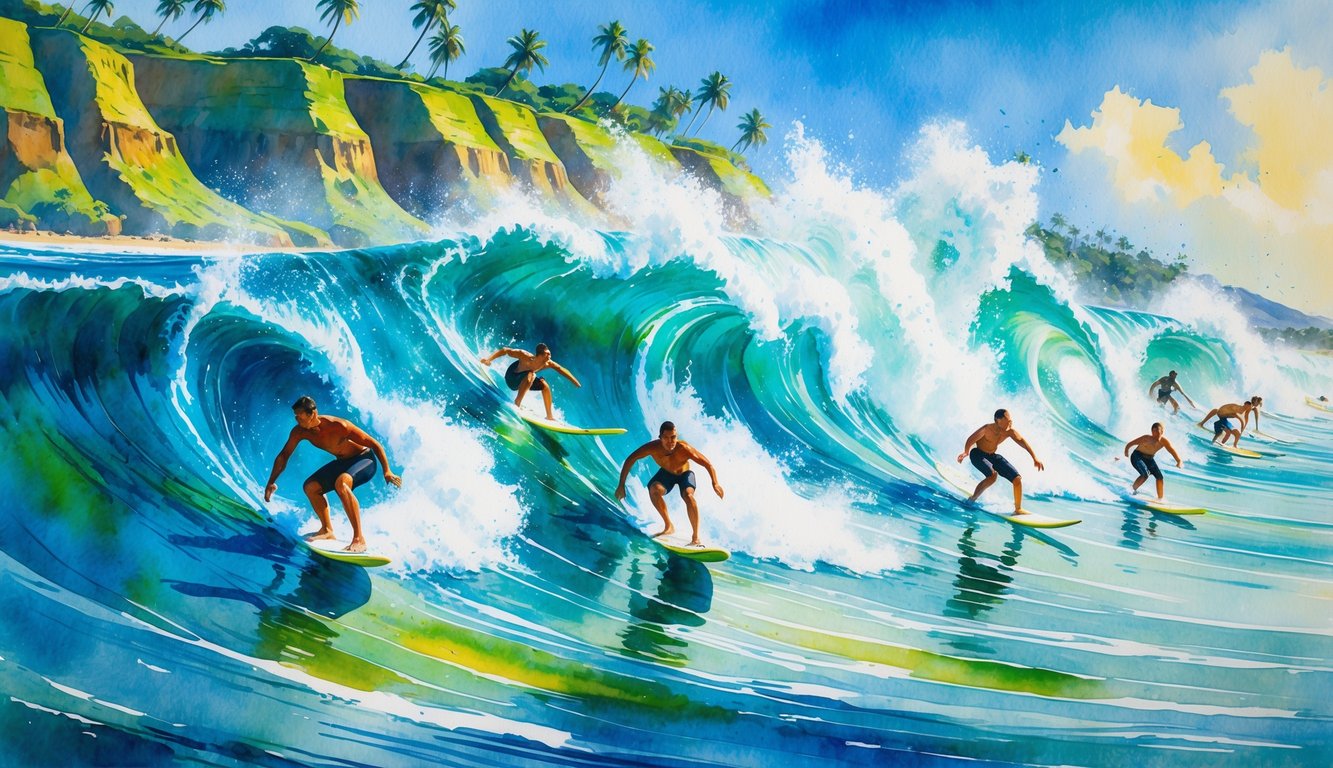
Hawaii has produced some of the world’s best surfers. These athletes have inspired both local communities and surfers worldwide with their skills and dedication.
Legendary Hawaiian Surfers
Early Hawaiian surfers left an amazing legacy. Duke Kahanamoku, often called the “father of modern surfing,” made surfing popular beyond Hawaii.
He won Olympic gold medals in swimming and showed surfing to crowds around the world. His efforts introduced the sport to thousands.
Eddie Aikau is another famous name. He became known for his courage as a lifeguard and his big wave surfing at Waimea Bay.
Every year, people celebrate Eddie’s life at the Eddie Aikau Big Wave Invitational.
Other legends like Buttons Kaluhiokalani and Rell Sunn also made big impacts. Rell Sunn helped grow women’s surfing and inspired many future champions.
Current Champions and Rising Stars
John John Florence is one of today’s top champions. He grew up on Oahu’s North Shore and quickly became one of the world’s best surfers.
John John has won several World Surf League titles. He often finishes at the top in Banzai Pipeline competitions.
Carissa Moore from Honolulu is another star. She started surfing at five and has become a top competitor.
Carissa has won several world titles. She is known for her powerful style and positive attitude.
The new generation includes talented young surfers featured in the Surf Girls Hawai’i series. These athletes keep Hawaii at the forefront of professional surfing by pushing new limits and earning spots on the Championship Tour.
World Surf League and Qualifying Events
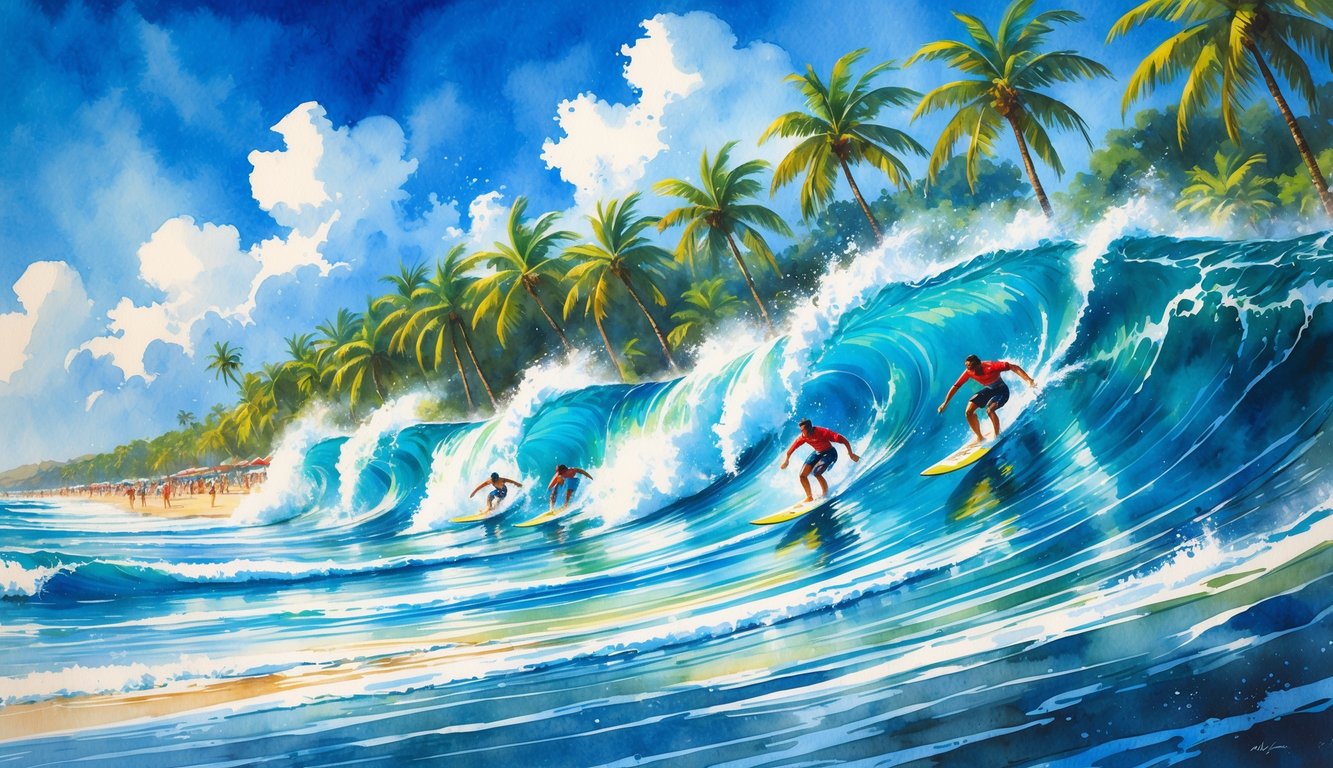
Hawaii is known for its beautiful beaches and major surf competitions. These include the World Surf League Championship Tour, the Challenger Series, and qualifier contests like the HIC Pro.
WSL Championship Tour
The World Surf League Championship Tour in Hawaii brings together the best surfers. Athletes compete for the world title at these events.
Hawaii usually hosts two big Championship Tour events—the Billabong Pipe Masters at Banzai Pipeline and the Hurley Pro Sunset Beach. The Pipeline event is famous for its huge waves and can be the final or first stop of the world championships.
Winners of these events earn major ranking points. Surfers from around the world try to qualify and compete here.
The waves at Pipeline and Sunset challenge even the best in the sport. You can find an updated schedule for these Hawaii surf competitions.
Challenger Series
The Challenger Series is a key step for surfers who want to join the Championship Tour. Here, rising talent competes for limited spots on the main tour.
Events like the Haleiwa Challenger and Hawaiian Pro are part of this series. These contests happen on Oahu’s North Shore, a legendary spot for big, consistent waves.
Surfers who do well can move up to the Championship Tour. The Challenger Series is intense because spots are limited, and every heat matters.
Top waves at places like Haleiwa test skill and nerve. Learn more about the North Shore’s surf competitions.
HIC Pro and Other Qualifiers
The HIC Pro is a major qualifying event in Hawaii. It takes place at Sunset Beach and is part of the World Surf League’s Qualifying Series.
Local and up-and-coming surfers compete here for a chance to reach bigger events. Surfers earn points at the HIC Pro to help them move up in the ranks.
The event usually happens before the main tour and often features standout performances from Hawaii’s athletes. Other important qualifier contests include the Hawaiian Pro and Haleiwa Pro.
These events attract skilled surfers from around the world. Everyone aims to collect enough points to advance to the next level.
For more on the HIC Pro, check out Hawaii’s most famous surf competitions.
Unique and Local Surfing Events
Every year, Hawaii hosts unique and local surfing competitions. These events celebrate surf culture, history, and community.
Da Hui Backdoor Shootout
The Da Hui Backdoor Shootout happens at Banzai Pipeline on Oahu’s North Shore. This invitation-only competition is known for big and challenging waves.
The event spotlights local Hawaiian surfers alongside global stars. A panel of respected watermen judges teams, making it feel more like family than a typical contest.
The event usually happens in early January, when Pipeline has its most powerful barrels. Community involvement and support are strong at the Shootout.
There is deep respect for Hawaiian culture and tradition here. A win is about pride and respect, not just points.
Buffalo’s Big Board Surfing Classic
Buffalo’s Big Board Surfing Classic takes place at Makaha Beach on Oahu’s west side. This event is about fun and honoring old-school Hawaiian surf traditions.
Surfers use oversized boards—some weighing 100 pounds—to compete in quirky, family-friendly divisions. Events include tandem surfing, canoe surfing, and stand-up paddleboard races.
The competition honors Buffalo Keaulana, a legendary Hawaiian waterman. Locals and tourists come together to celebrate.
Generations of Hawaiian surfers gather to share stories and teach surf etiquette to visitors. The contest welcomes all ages and skill levels.
Everyone is encouraged to try something new. This joyful approach shows what makes Hawaii’s surfing events special.
Local Motion Surf Into Summer
Local Motion Surf Into Summer happens every May on the South Shore of Oahu. It is one of the biggest amateur surf competitions in Hawaii.
Many pro surfers started by winning or placing here. The event is open to all skill levels, from young groms to older adults.
There are divisions for shortboard, longboard, and bodyboard heats. The beach is always packed and excitement fills the air.
Local Motion, a well-known Hawaiian surf brand, runs the contest. Prizes, gear, and a chance to show off skills make it a highlight for local surfers.
For many, it marks the start of summer and the surf contest season.
Pipe Bodyboard Championship
The Pipe Bodyboard Championship is a highlight each year at Banzai Pipeline. This event gives bodyboarders a chance to compete on the same waves as elite surfers.
Top bodyboarders from around the world come to take on Pipeline’s hollow barrels and strong currents. Surfers compete in elimination heats and aim to ride the best waves.
Judges reward high-risk maneuvers and deep barrel rides. The event is intense and showcases the close community of the sport.
Many surfers stay to watch and support their friends. The championship is a true test of courage and skill at one of Hawaii’s most respected surfing events.
Event Timing, Surf Seasons, and Conditions
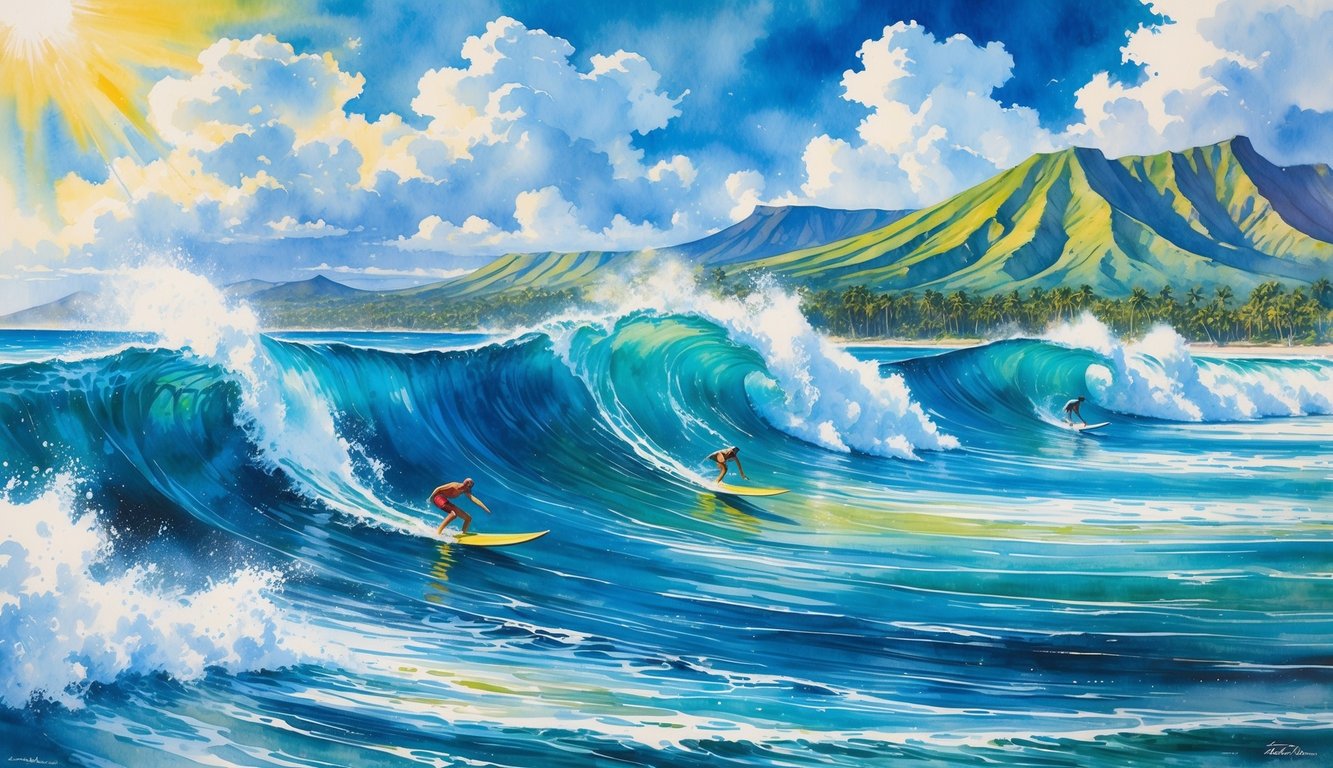
When I look for the best surfing competitions in Hawaii, I pay close attention to the time of year, event planning, and the surf conditions at famous breaks. Knowing these details helps me catch the most exciting action.
Best Time of Year for Competitions
Most surfing competitions in Hawaii happen during winter, from late September to April. The biggest and most consistent waves reach the islands during this time, especially on Oahu’s North Shore.
Events like the Pipe Masters and other major contests are scheduled when waves are strongest. December through February often has the highest wave activity.
This window draws top surfers from around the world. The high surf season focuses on famous breaks like Banzai Pipeline, Sunset Beach, and Waimea Bay.
These locations only get massive, contest-worthy waves during winter. Powerful North Pacific storms create these surf conditions.
You can check a full Hawaii surf contest schedule for events during this peak period.
Understanding the Holding and Waiting Periods
A key part of Hawaii surf contests is the “holding period” or “waiting period.” Events don’t always have a fixed date.
Organizers set a window of days or weeks for the competition. Each day, officials watch surf reports and weather to choose the best days for heats.
This system means contests only run when wave conditions are safe and ideal. For example, the Billabong Pipe Masters might have a two-week waiting period, but the event itself could finish in just 3-4 days.
Typical waiting period features:
- Lasts 7 to 21 days
- Lets organizers pick the best swell
- Helps avoid flat spells or dangerous surf
I recommend following event updates online, since contest days are often announced with short notice.
Typical Surf Conditions
Winter brings large, powerful swells to Hawaii. This makes it perfect for high-level competitions.
Surf conditions can range from eight-foot faces to massive twenty-foot waves, depending on the break and swell. North Shore breaks like Pipeline are famous for steep, barreling waves.
Sunset Beach offers longer rides with big, challenging peaks. The water is intense, and currents can be strong.
Even on smaller days, the waves hit hard and move fast. Here’s a quick guide to common conditions at top contest surf breaks:
| Surf Break | Typical Winter Wave Size | Wave Type |
|---|---|---|
| Banzai Pipeline | 8-20+ feet | Hollow, barreling |
| Sunset Beach | 10-20 feet | Powerful, peaky |
| Waimea Bay | 15-30+ feet (rarely breaks) | Giant, heavy outer reef |
I always check surf reports before going out, as weather, wind, and tides can change conditions quickly.
Famous Surfing Venues and Viewing Spots
Hawaii has some of the best places for watching top surfing events. These spots often host major competitions and bring together fans and athletes from around the world.
Ali’i Beach Park
Ali’i Beach Park sits in Haleiwa, on the North Shore of Oahu. I love visiting because the Vans Triple Crown of Surfing starts here, which is a very famous event.
This beach offers long, rolling waves that suit surfers of all levels, from beginner to pro. I often see crowds lining the sand and people sitting in the grass behind the beach.
The vibe feels friendly and laid back. Everyone gets excited when the waves pick up and top surfers enter the water.
Public facilities like restrooms and picnic tables make it easy to spend a whole day by the ocean. Parking fills up quickly during big contests, so I try to arrive early.
I recommend bringing binoculars for a closer look at the action. For more event details, check the Hawaii’s most famous surf competitions guide.
Turtle Bay Area
The Turtle Bay Area sits at the northernmost tip of Oahu. I like this spot because the waves are powerful but more spread out than at other North Shore beaches.
Pro surfers often visit for both free surfing and practice. Turtle Bay Resort is nearby, so finding food and a place to relax between heats is easy.
Several viewing points line the small trails and paths that lead to different surf breaks. The area feels less crowded than other famous beaches, so I have more room to watch.
The scenery here is stunning, with clear blue water and a green shoreline. It’s a great place to take photos or enjoy the energy of the surfing community.
For more on famous breaks in this region, check out the best surf spots in Hawaii.
The Future of Surf Competitions in Hawaii
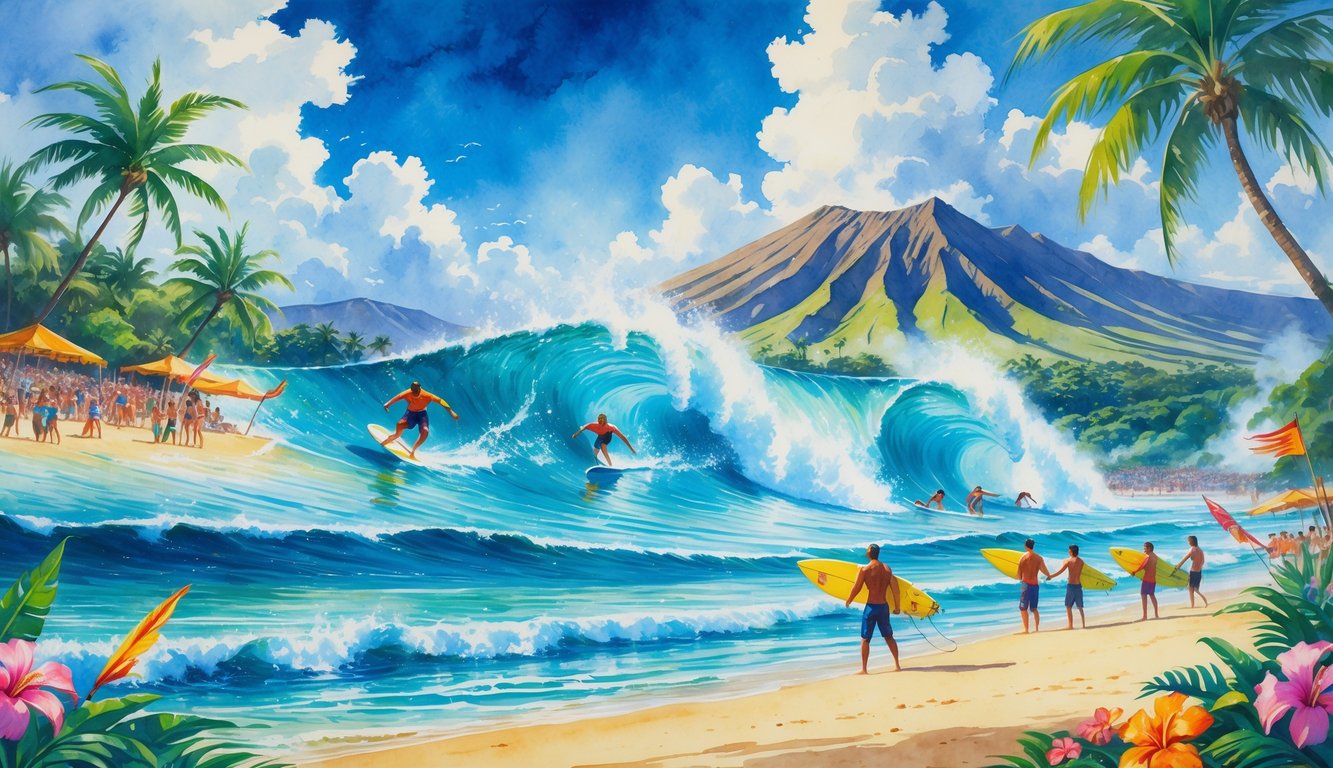
Surfing competitions in Hawaii keep changing. Organizers and surfers work together to balance tradition, new ideas, and respect for the environment.
Emerging Events and Changing Trends
I see more diverse surfing events appearing across Hawaii. Traditional contests like the Vans Triple Crown and the Eddie Aikau Invitational still draw big crowds.
Now, specialized events for women, youth, and longboarders are growing. The China Uemura’s Annual Wahine Surfing Classic and Roxy Waikiki Classic at Kuhio Beach give female surfers a chance to compete and celebrate their skills.
More amateur and community-focused competitions help make the sport accessible for everyone. Another key trend is better scheduling and the use of “holding periods,” so competitions happen only when waves are at their best.
This keeps the action exciting for surfers and fans. You can check out a detailed surfing contest schedule for Hawaii to see how events now cover the whole year, from Oahu to Maui and Kauai.
Sustainability and Community Initiatives
Sustainability in Hawaiian surf contests keeps growing. Event organizers try to minimize plastic waste and use eco-friendly products at surf sites.
Some contests organize volunteer beach clean-ups. They also include recycling drives in the event schedule.
Local foundations and surf communities play a big role. They support youth surf programs and teach ocean safety to raise future generations of surfers.
Many competitions work closely with Hawaiian cultural groups. These groups honor native customs and include blessings before the event starts.
This connection to tradition and community gives the surf scene its unique spirit. It helps keep Hawaiian surfing competitions special for surfers and fans.




